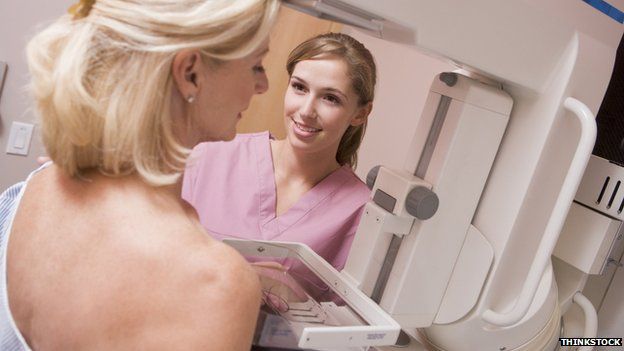Breast cancer risk test devised in 77-gene analysis
- Published

Scientists have predicted the odds of women developing breast cancer by looking for tiny errors in their DNA.
The international team analysed 77 genes. Individually they each had a low impact on cancer risk, but were a powerful combination.
The findings, in the Journal of the National Cancer Institute, could eventually transform screening, preventive treatments and even HRT.
Cancer charities said the field was developing rapidly.
The genetic tests that have already been developed are restricted, in the UK, to those women with the very highest risk of developing breast cancer.
They look for changes such as mutations in the BRCA genes that led the Hollywood actress Angelina Jolie to have her breasts and ovaries removed.
They can give up to a 90% chance of cancer in a woman's lifetime, but are rare.
'Very exciting'
The team, led by the Institute of Cancer Research in London and the University of Cambridge, looked at the parts of the genetic code that have a more subtle effect yet will influence every woman's chance of cancer.
Of the 77 cancer-risk sites in the DNA inherited from the mother and the matching 77 from the father, an average woman would have 66.
It allowed the team to calculate the probability of women developing breast cancer.
- In women with no family history of breast cancer, the highest-risk group had a 16.6% lifetime risk
- In women with no family history of breast cancer, the lowest-risk group had a 5.2% lifetime risk
- In women with a family history of breast cancer, the higher-risk group had a 24.4% lifetime risk
- In women with a family history of breast cancer, the lowest-risk group had a 8.2% lifetime risk
"These are quite substantial risks," said Prof Montserrat Garcia-Closas, of the Institute of Cancer Research.
She told the BBC News website: "I think it's very exciting at the moment. The discovery of these variants has progressed very quickly in the last five years and I think it's reaching a plateau. And at that point it's time to start designing a genetic test that includes all these elements. That's likely to be reached within a year."
The ability to accurately predict the risk of breast cancer could have a powerful impact on medicine.
It could clearly show which women need drugs, such as tamoxifen and raloxifene, to reduce the risk of breast cancer.
The lowest-risk women may not need breast cancer screening, while those at highest risk might need to start earlier.
Hormone replacement therapy has many benefits, but it does increase the risk of cancer. So knowing the background genetic risk could also inform who should and should not have HRT.
'Major step'
But one of the great challenges will be to combine these tests with current techniques.
Prof Douglas Easton, of the University of Cambridge, said: "We've now reached a crucial stage at which all this research can be combined to help target screening and advice to those women who need them the most.
"There's still work to be done to determine how tests like this could complement other risk factors, such as age, lifestyle and family history, but it's a major step in the right direction that will hopefully see genetic risk prediction become part of routine breast screening in the years to come."
Dr Matthew Lam, of the charity Breakthrough Breast Cancer, said: "In recent years we've learnt so much about genetic risk factors of breast cancer. What's great to see now is that these findings are starting to be translated into practical methods to predict risk."
Nell Barrie, of Cancer Research UK, said: "This study shows how the genetic map of breast cancer that scientists have been building up over the years might be used to identify women most at risk, so we can take steps to reduce their chances of developing the disease or catch it at the earliest possible stage."
- Published25 June 2013
- Published25 July 2014
- Published18 April 2012